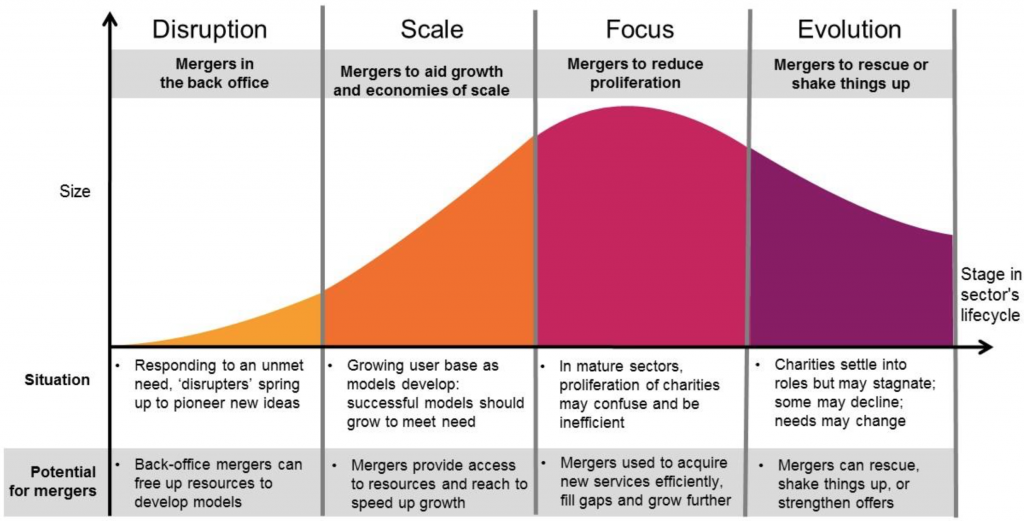4 min read
Summary Points:
- New Philanthropy Capital is interested in sharing their research result about social mergers in the U.K. in Japan.
- Find out how mergers and sharing models can help charities better achieve their mission according to its lifecycle here.
Each year 50-70 registered charities merge in the UK. This might sound plenty until you consider that annually 5,000 charities close—wasting significant assets in expertise, resources and ideas in the process.
A merger is not a ‘silver bullet’, but if considered early enough, at least some of these social organizations could have avoided closure or efficiently passed on their assets to other nonprofits.
Mergers in Japan
Mergers between Japanese corporate companies are common with 3,000 deals taking place last year. This is no surprise as Japan is a global center for business and has the third-largest economy. But this activity does not translate to its social sector—the only recent example is Oisix.dachi Inc in the organic food sector.
Japan’s nonprofit sector is smaller and younger than in the UK, which may explain the lack of mergers. But there are also reasons why Japan is ripe for more social mergers:
- Japanese nonprofits are very business-oriented with most involved in trading services—which should make the business case for mergers clearer.
- Most nonprofits in Japan are small—if some were to merge to become larger, they could reap benefits from working at scale with a greater reach.
- As a relatively young sector, the appetite for mergers will increase as organizations start to mature—some will be struggling to continue, while others will be looking for shortcuts to expand.
NPC’s research
For these reasons, ‘Let’s talk mission and mergers’ by New Philanthropy Capital (NPC) in the UK should also interest nonprofits and their funders here in Japan. Our research involved over 50 interviews and concluded that mergers can be a powerful tool to achieve more impact. The report explains the different merger models, provides detailed case studies and makes recommendations to overcome barriers to mergers.
Here are the 5 key highlights from the report:
Finding 1: Mergers are controversial
Mergers are about identity, so it is understandable that this topic can be controversial—but it often provokes an unhelpful binary argument. One party may claim that there are too many nonprofits while others characterize mergers as inherently inconsistent to how nonprofits should behave.
It’s time to change the narrative and start talking constructively about how and when mergers can be used as a tool to achieve more impact.
Finding 2: The merger spectrum
‘The merger’ in reality is a catch-all term for a myriad of models, but we often use it only to describe takeovers. It’s time to expand our definition and consider the true range of underused merger options.
The merger and sharing model spectrum, from ‘Let’s talk mission and mergers’ (NPC)
Finding 3: Different types of merger impact
Our research found three distinct types of impact:
- Strategic impact: combined expertise, increased reach and a clear voice can address social causes more effectively
- Cost savings: efficiency gains can be recycled into spending more on mission—a nonprofit from our research made savings of ¥440billion!
- Financial sustainability: mergers can rescue weak nonprofits or spur financial growth in strong nonprofits, improving the chances of long-term survival
Finding 4: The nonprofit’s lifecycle matters
Mergers will not suit all social organizations in all situations, which is why it is useful to consider a nonprofit in terms of their lifecycle or stage of development—see the diagram below. Whether a start-up or a mature organization, the appropriate merger aims or merger models are likely to differ stage by stage. For the charity where I previously worked, a merger came 200 years into its history.
Mergers in the life-cycle of a sector or charity, from ‘There is more than one way to merge a charity: part 1’ (NPC)
Finding 5: Funders have a role to play
Finally, there are a number of ways that philanthropists and other funders of nonprofits can support mergers to create social impact, for example by encouraging networking, funding merger costs and by not acting as a deterrent.
There is also a powerful case for funders to start thinking about merging themselves.
To find out more, sign up to attend the AVPN seminar with me on 8 August, 6:30-8:30pm at The Nippon Foundation, Tokyo.




















